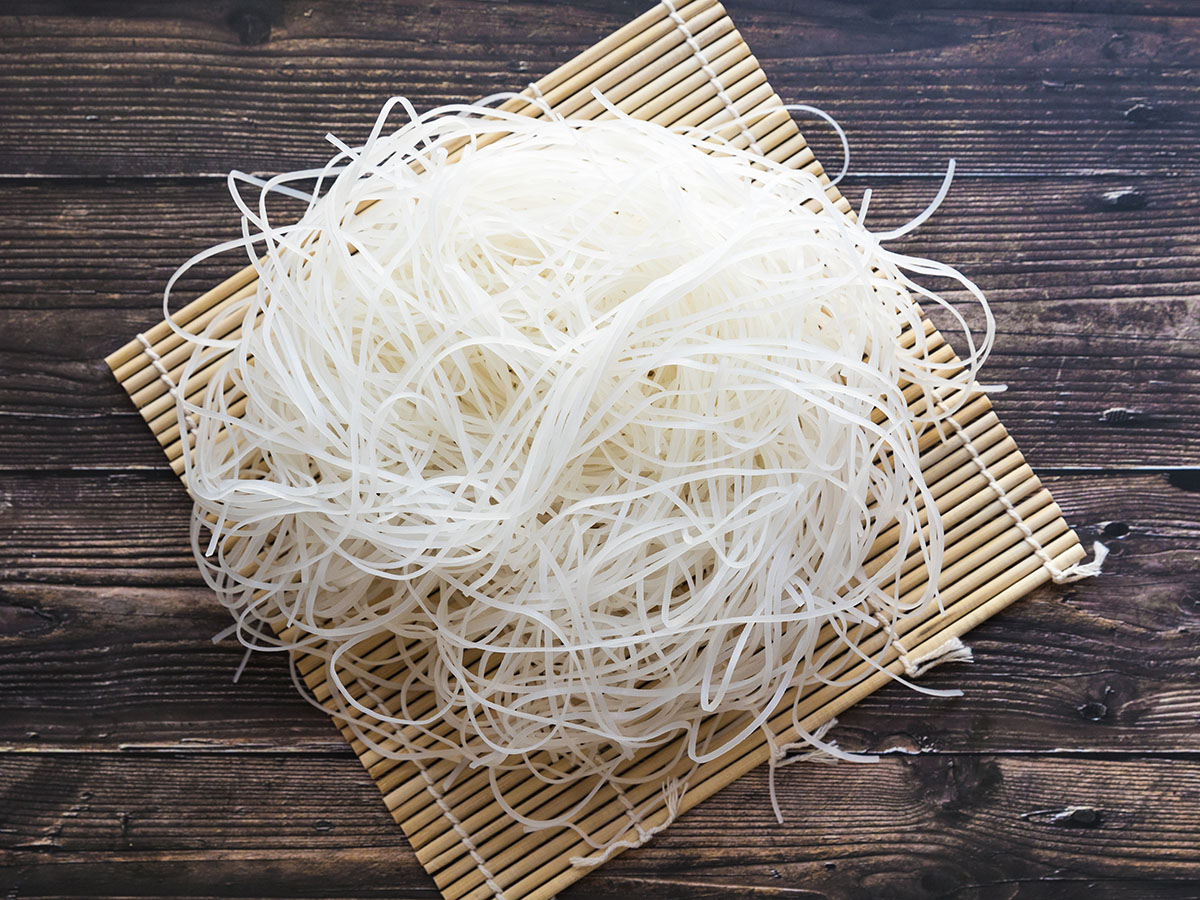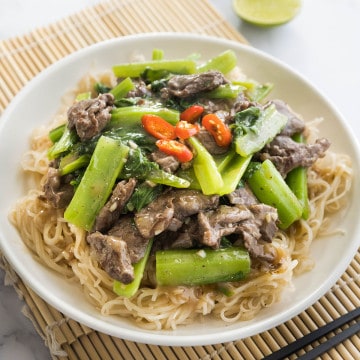Pho Tai features super tender slices of beef, perfectly cooked by the piping hot, savory bone broth.

If you've been to an authentic Pho restaurant, you've undoubtedly been presented with a long list of Pho options. You'll quickly notice that a bowl of Vietnamese Pho often comes with many types of protein choices in several different combinations. Some include rare steak (tái), brisket (gầu), well done steak (chín), flank (nạm), tripe (sách), tendon (gân), and beef meatballs (bò viên), whew! It quickly becomes overwhelming.
Phở Tái or rare steak, may be the simplest of the beef options. However, don't let the word "simple" fool you. Thin slices of raw beef are layered on top of the pho rice noodles, which cooks when piping hot broth is poured over it. There's something almost magical about the process. The thinly sliced beef is cooked to perfection every time, leaving you with a tender texture that keeps you coming back for more.
Which Cut of Beef is Best for Pho Tai?
Of course, the star of the show for Vietnamese Pho Tai is thinly sliced beef. The most popular choices are eye of round, ribeye and tenderloin. I typically opt for ribeye since it's more tender than eye of round and less pricey than tenderloin.
If you're able to, have the butcher slice the beef no more than ⅛" thick. If you prefer to slice the meat yourself, put it in the freezer for a few hours until it has firmed up but not rock solid. This makes it easier to make thin, even slices.
If do decide to use ribeye, only use the eye portion. Pull off the rib cap and save it for another Vietnamese favorite, such as Bo Luc Lac.
Pho Noodles 101

Pho noodles, aka banh pho or rice stick noodles, are an essential ingredient so try to get the best noodles available to you. If you're lucky enough to get your hands on fresh pho rice noodles, it's definitely the way to go. You can find fresh banh pho in Vietnamese, Chinese and sometimes Korean grocery stores. They're often kept with other freshly made rice noodles.

If fresh pho noodles are difficult to find in your area, dried banh pho would work as well. Luckily, you can find them in most grocery stores and even online. Keep in mind that dried rice stick noodles require soaking in warm water prior to cooking. Consequently, they require some planning but they're convenient to have around since they're shelf stable.
Some dried rice stick noodle brands are better than others so definitely don't give up if it doesn't work out the first few times. Three Ladies Brand and Caravelle are good options. Go for banh pho labeled size small. Those will be the closest to the pho noodles we all know and love.
How to Make Vietnamese Pho Tai
The photograph below captures the ingredients that are needed to make Pho broth. Loads of spices and beef bones are the essence of this dish. I like choosing beef bones with some marrow and meat attached. It gives the broth a good balance of flavors.

QUICK TIP: As with most stocks, you should parboil the beef bones to remove the impurities. This is an extra step but it'll yield a lovely clear broth. Most cooks (my parents included) use the final stock pot to parboil the bones, dump out the water, clean the pot and bones, then fill up the large pot again. This method works, but I use a 12 quart stock pot and trying to handle a large pot of boiling water is difficult, not to mention dangerous. Instead, I boil the bones in a smaller pot before transferring them to the final stock pot. This makes parboiling much more manageable and minimizes the danger factor.
Let's make Vietnamese Pho Tai!

1) Give the beef bones a good rinse. Place them on a cookie sheet and air fry or bake for 20 minutes at 400°F.

2) In a skillet on medium-high heat, char the halved onion and ginger slices on both sides. Don't use any oil for this step.

3) Toast the spices in a skillet over low heat. Stir continuously until the spices begin to lightly brown and release their beautiful aroma. Add coriander seeds toward the end since they're very small and toast quickly.

4) Fill a large stock pot with 6 quarts of water and bring to a boil. Meanwhile, in a smaller pot, boil the browned beef bones for 10 minutes to draw out the impurities. Drain and rinse the impurities off the bones.

5) Put the spices in a spice/tea bag or wrap in cheese cloth. Transfer the bones into the large stock pot along with the onion, ginger, fish sauce, salt, sugar and spice pouch.

6) Bring to a boil then cover and simmer over medium-low heat. Keep the lid slightly cracked open. The broth should be at very low simmer. Replenish the water as necessary.

7) After 6 hours, fish out the onion, ginger and spice pouch. The onion can be discarded or enjoyed in the Pho Tai.

8) By now, the bones have released all its flavor resulting in a very rich, beefy, bone broth.

9) Use a fat skimming ladle to remove the thick layer of fat on the surface. A gravy separator also works well. Or simply skim off the fat with a ladle.

10) For a clear broth, use a fine mesh strainer to strain out any impurities or bits floating in the soup. Season with additional fish sauce and salt to taste.
How to Build a Bowl of Pho Tai
Begin by cooking the noodles, one serving at a time. If you're using dried banh pho, soak the noodles ahead of time according to the package instructions. Place a portion of rice noodles in a fine mesh strainer with a handle or noodle strainer and lower it into a pot of boiling water for 5 seconds. It's best to cook the noodles al dente since it'll continue to soften as it sits in the hot broth. Drain and shake out the excess water and transfer the noodles into a large soup bowl.
Place a layer of sliced beef on top along with thinly sliced white onions, chopped scallions and cilantro. Carefully ladle boiling broth over the raw beef. The hot Pho broth will cook the beef to perfect tenderness. Finish off with your desired toppings.
It's important to note that Pho Tai needs to be prepared one bowl at a time and served right away. Cooked rice noodles stick together and are difficult to separate if left to sit without soup. And once you pour broth over it, it'll continue to soften and get mushy. Not to mention, the beef will also become overcooked.

How to Eat Pho
Vietnamese Pho is always served with a large variety of toppings which include:
- chopped scallions
- cilantro
- thinly sliced white onions
- bean sprouts
- basil leaves
- sliced jalapenos
- lime
- freshly cracked black pepper
To enjoy the beef, fill a condiment dish with half hoisin sauce and half sriracha and dip the beef slices into it.
For those how love gnawing on beef bones (me!), don't forget to add one to your soup or on the side. There's still lots of meat and tendon on the bone to enjoy and sometimes even marrow!
The great thing about making Pho Tai at home is that not only is it healthier and doesn't contain MSG, you can customize it however you'd like. You'll always get to enjoy your version of the perfect bowl of Pho Tai.
Ingredients
- 4-5 lbs beef bones
- 1 whole onion, outer layer removed, cut in half through the base
- 6-8 slices of ginger
- ¼ cup fish sauce
- 1 tablespoon salt
- 1 tablespoon sugar
- 2 lbs pho rice stick noodles, fresh or dried
- 1 lb beef (ribeye, eye of round or tenderloin), thinly sliced
SPICES
- 3-5 cinnamon sticks
- 5 black cardamom pods
- 8-10 star anise
- 2 tablespoon coriander seeds
- 1 teaspoon ground cloves or whole cloves
Instructions
Cooking the Broth
- Rinse the beef bones and place them on a cookie sheet. Air fry or bake at 400°F for 20 minutes until browned.
- Transfer the beef bones to a medium-sized pot. Fill with water and boil for 10 minutes to draw out the impurities from the bones.
- Drain the bones and rinse off any scum. Transfer the bones to a large stock pot with 6 quarts of water and bring to a boil.
- Heat a skillet over medium-high heat and without oil, char the halved onion and ginger slices on both sides. Transfer into the large stock pot.
- Turn the heat to down to low for the skillet. Add the SPICES (cinnamon sticks, cardamom pods, star anise, and cloves). Again, do not use any oil. Gradually toast the spices to bring out the flavors. Stir periodically until they become aromatic and darkens in color. Add the coriander last since they're small and brown quickly.
- Put the spices in a spice/tea bag or wrap and tie them in a cheesecloth. Add the spice pouch to the stock pot along with fish sauce, salt and sugar.
- Bring to a boil then lower the heat to a simmer, cover with the lid slightly ajar. Simmer for 6 hours. Replenish the water as needed.
- During the 6 hours, periodically skim any scum or impurities off the surface of the broth.
- After 6 hours, remove the spice pouch, ginger slices, and onion halves. Skim off as much fat as you can. To make the broth as clear a possible, use a fine mesh strainer to strain out impurities and any bits you see.
- Add more salt and fish sauce to taste. The broth should taste slightly on the salty side. Once the broth is poured over noodles and toppings added, the flavor gets diluted.
Cooking the Noodles
- If you're using dried pho rice noodles, be sure to rehydrate ahead of time according to the package instructions.
- Bring a pot of water to a boil.
- One serving at a time, place a handful of noodles into a fine mesh strainer with a handle or a noodle strainer. Lower it into the boiling water for 5 seconds. Remove the strainer and shake out the excess water. Transfer the noodles to a large soup bowl. Cook the noodles al dente since it'll continue to soften in the broth.
Putting it All Together
- To assemble a bowl of Pho Tai, add freshly cooked noodles in a bowl. Top with thinly sliced raw beef, onions, scallions and cilantro.
- Ladle hot broth over the beef. Top with fresh bean sprouts, basil, jalapenos, black pepper and a squeeze of lime.
- Serve with hoisin sauce and sriracha for dipping the meat as well as a side of broth with a bone.






Join the Discussion